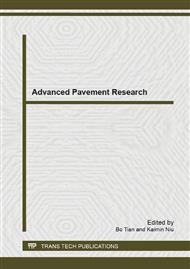[1]
Saul A G A. Principles underlying the steam curing of concrete at atmospheric pressure. Magazine of Concrete Research. 2(6) (1951) 127-140.
DOI: 10.1680/macr.1951.2.6.127
Google Scholar
[2]
Carion N J. Maturity Method: theory and application. Cement, Concrete And Aggregate. 1984, 6(2) (1984) 51-73.
Google Scholar
[3]
Carion N J. The Maturity Method, in handbook on Nondestructive Testing of Concrete. Boca Raton: CRC Press, 1991, pp.101-146.
Google Scholar
[4]
Bergstom S G. Curing temperature, age and strength of concrete. Mag. Concr. Res. 5(14) (1951) 61-66.
Google Scholar
[5]
Mcintosh J D. The effects of low-temperature curing on the compressive strength of concrete. RILEM SYMPOSIUM: Winter Concreting. Great Britain, Section B, (1956).
Google Scholar
[6]
Alexander K M, Taplin J H. Concrete strength, cement hydration and the maturity rule. Australian Journal of Applied Science. 13 (1962) 277-284.
Google Scholar
[7]
P. F H, J. P. Maturity computer for controlled curing and hardening of concrete. Journal of the Nordic Concrete Federation. 21(1) (1977) 19-34.
Google Scholar
[8]
ASTM C1074-11. Standard Practice for Estimating Concrete Strength by the Maturity Method. West Conshohocken.
Google Scholar
[9]
Chanvillard G, Laetitia D. Concrete strength estimation at early ages: modification of the method of equivalent age. ACI Materials Journal. 94(6) (1997) 520-530.
DOI: 10.14359/336
Google Scholar
[10]
Jonasson J E. Early strength growth in concrete: preliminary test results concerning hardening at elevated temperatures. in: Finland: Technical Research Centre of Finland, (1985) 249-254.
Google Scholar
[11]
A. A Y. The reliability of the Saul-function for concrete maturity. in: Cairo, Egypt.: Cairo University Press, 1991, p.122~137.
Google Scholar
[12]
Tank R C, Carion N J. Rate constant functions for strength development of concrete. ACI Materials Journal. 88(1) (1990) 74-83.
Google Scholar
[13]
Abdel-Jawad Y A. Estimating concrete strength using a modified maturity model. Proceedings of the ICE-Construction Materials. 159(1) (2006) 33-37.
DOI: 10.1680/coma.2006.159.1.33
Google Scholar
[14]
Kim J, Han S H, Song Y C. Effect of temperature and aging on the mechanical properties of concrete: Part I. Experimental results. Cement and Concrete Research. 32(7) (2002) 1087-1094.
DOI: 10.1016/s0008-8846(02)00744-5
Google Scholar


